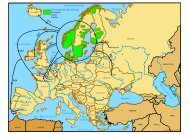You also want an ePaper? Increase the reach of your titles
YUMPU automatically turns print PDFs into web optimized ePapers that Google loves.
Teacher InformationTropical rainforests are home to such diversity for several reasons. The first is that overthe past 100 million years, l<strong>and</strong>s near the equator remained fairly undisturbed by sea levelchange, climate change, or glaciation. This allowed many different animals <strong>and</strong> plants toevolve over long periods of time. Because there are no seasons along the equator, onlyconstant high temperatures, lots of humidity <strong>and</strong> rainfall, <strong>and</strong> intense sunlight, conditionsare perfect for the growth of thous<strong>and</strong>s of plant species. Diverse rainforest plants providehighly varied resources for animal life, <strong>and</strong> have evolved into thous<strong>and</strong>s of species.Butterfly <strong>and</strong> moth species live at specific heights in the rainforest. In a typical rainforestthere are at least 4 layers or strata:1) Ground layer or Forest Floor- herbs, ferns, <strong>and</strong> low shrubs2) Understory layer- shade-tolerant small trees, mosses, lichens, ferns3) Canopy layer- tops of tall trees, as many as 400 species per square mile4) Emergent layer- extraordinarily tall species that rise above the canopy layer.Most Lepidoptera species rarely leave a familiar environment. Some live hundreds of feethigh in the rainforest canopy, while others fly close to the ground or rest in leaf litter. Eachis adapted to a certain temperature, humidity, <strong>and</strong> light range, <strong>and</strong> stays at its favoritestrata.Florida Museum of Natural History http://www.flmnh.ufl.edu 5
















